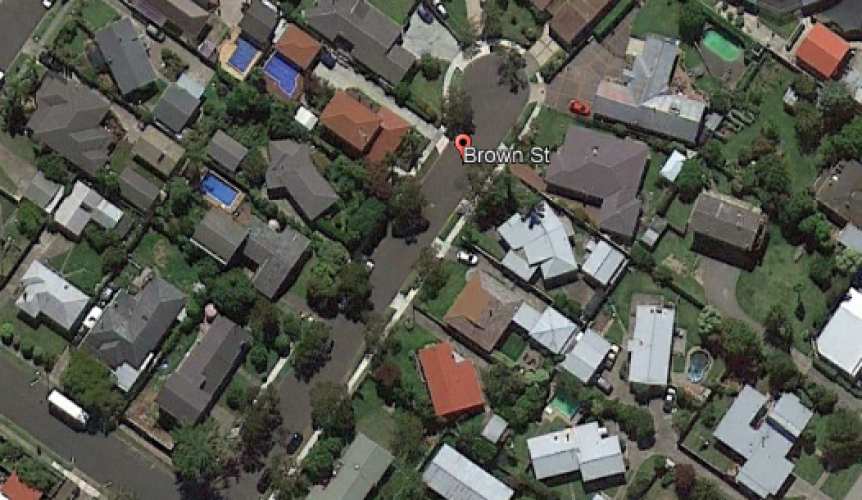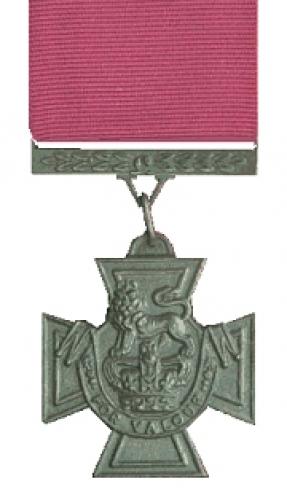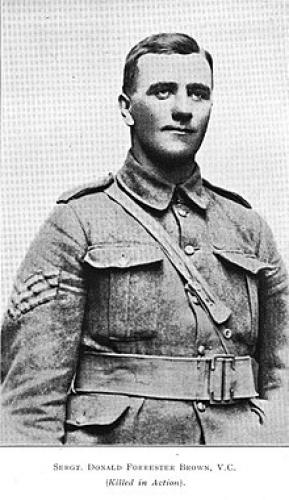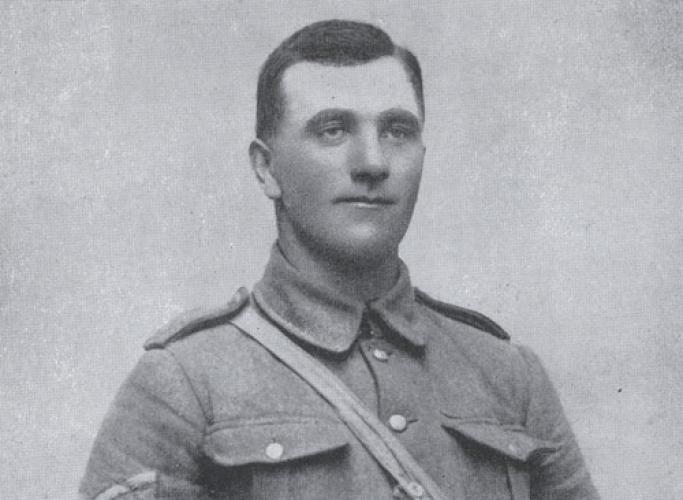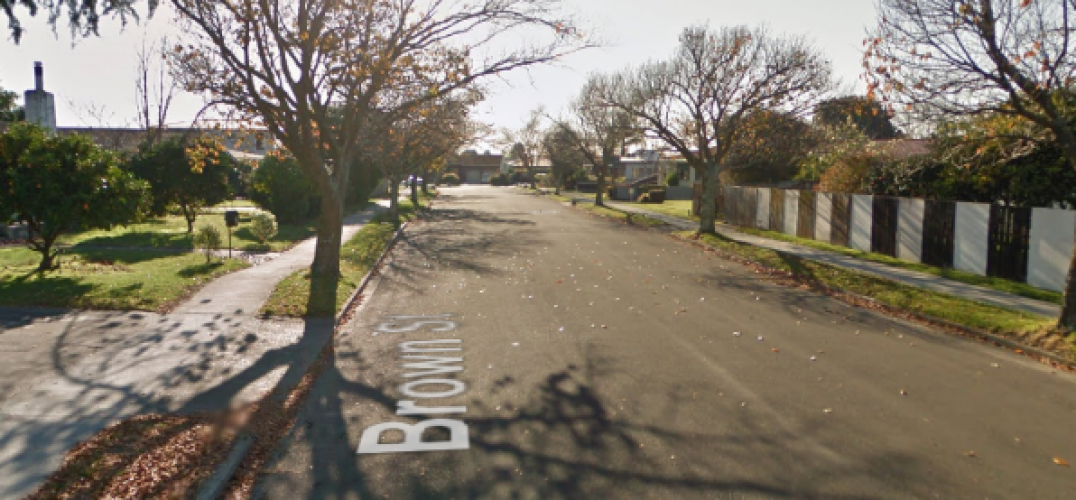225 Brown Street Taradale, Napier, street scene 2018
Reason for the name
This Taradale Street was named in honour of Sergeant Donald Forrester Brown who was the first member of the New Zealand Expeditionary Force to be awarded a Victoria Cross on the Western Front during World War 1. There are many streets in Taradale named after Victoria Cross winners from all wars.
Donald Forrester Brown, VC (23 February 1890 – 1 October 1916) was a New Zealand recipient of the Victoria Cross (VC), the highest award for valour "in the face of the enemy" that can be awarded to British and Commonwealth forces.
Born in Dunedin, Brown was a farmer when the First World War began. In late 1915, he volunteered for service abroad with the New Zealand Expeditionary Force (NZEF) and was posted to the 2nd Battalion, the Otago Infantry Regiment. He saw action on the Western Front and it was during the Battle of Flers–Courcelette in September 1916 that he performed the actions that led to the award of the VC. As he was killed several days later during the Battle of Le Transloy, the award was made posthumously. His VC was the second to be awarded to a soldier serving with the NZEF during the war and was the first earned in an action on the Western Front.
Author: The Poppy Places Trust
Brown was born on 23 February 1890 in Dunedin, New Zealand. He was one of 10 children of Robert Brown, a draper living in Oamaru, and Jessie McFarlane. His parents were migrants from Scotland who had married in New Zealand. Brown was educated at South School and then went on to Waitaki Boys' High School in Oamaru. After completing his schooling, he took up farming and by 1913, had purchased a farm at Totara.
When the First World War broke out, Brown continued to work on his farm for a year but then sold it and volunteered for the New Zealand Expeditionary Force (NZEF) on 19 October 1915. He received his training at Trentham Military Camp and embarked for the Middle East in January 1916 with the Ninth Reinforcements. By this time he had been promoted to corporal. The newly formed New Zealand Division was training in Egypt and when Brown arrived, he was posted to the 2nd Battalion, Otago Infantry Regiment. Within a few months he was on the Western Front in France with the rest of the division.
On arrival in France, the New Zealanders were assigned to the Armentières sector of the Western Front. This area was considered to be a "nursery" sector, for introducing inexperienced troops to the Western Front. Brown's battalion was initially positioned to the east of Armentières. Despite being a quiet part of the front, it was still exposed to artillery and sniper fire. The battalion rotated regularly in and out of the front line, as it gained experience in trench warfare. In August 1916, the division began transferring to the Somme sector.
The next month, Brown, by now a sergeant, was involved in the Battle of Flers–Courcelette, part of the Somme offensive. On the opening day of the battle, 15 September, his unit had to capture a series of German held trenches from their position south-east of High Wood. While the first trench was easily captured with the assistance of effective artillery support, his company came under heavy flanking machine gun fire while advancing to the next trench line, which caused many casualties in the company. Brown, together with another soldier, Corporal Jesse Rodgers, attacked one machine gun post, killing the crew and capturing the gun. The remaining soldiers regrouped and prepared for an attack on the next trench. During a covering artillery barrage they once again came under fire from a machine gun post. Brown was amongst those who attacked this second machine gun post, swiftly dealing with the threat.
Once the covering barrage lifted, the New Zealanders advanced and captured their next objective, the Switch Line. Brown was key in immediately improving the existing defences in preparation against a possible counterattack. The following day, his battalion was relieved and withdrew from the front line. Brown's company lost 123 men from its initial complement of 180 during the opening day of the battle.
The Otago Regiment was back in the front line on 1 October for the Battle of Le Transloy. In an attack on a German strongpoint near Eaucourt L'Abbaye, Brown was again involved in the seizing of an enemy machine gun post which was holding up the advance. Moving forward on his own, armed only with a pistol, Brown attacked the post. He managed to kill its crew and capture the gun. This allowed his fellow troops to attack and capture the strongpoint. During this attack, Brown was shot in the head by a sniper and killed instantly.
Brown's company commander had recommended him for a Distinguished Conduct Medal for his actions on 15 September. In a letter to Brown's father, his battalion commander hoped that the recommendation would be upgraded to a Victoria Cross (VC). The VC, instituted in 1856, was the highest award for valour that could be bestowed on a soldier of the British Empire. With Brown's death, it was not until the officers of his battalion lobbied for a VC nomination that any progress was made. The award of the VC to Brown was gazetted on 15 June 1917. The citation reads:
For most conspicuous bravery and determination in attack, when the company to which he belonged had suffered very heavy casualties in officers and men from machine gun fire. At great personal risk this N.C.O. advanced with a comrade and succeeded in reaching a point within 30 yards of the enemy guns. Four of the gun crew were killed and the gun captured. The advance of the company was continued until it was again held up by machine gun fire. Again Sergeant Brown and his comrade, with great gallantry, rushed the gun and killed the crew. After this second position had been won, the company came under very heavy shell fire, and the utter contempt for danger and coolness under fire of this N.C.O. did much to keep up the spirit of his men. On a subsequent occasion in attack, Sjt. Brown showed most conspicuous gallantry. He attacked, single handed, a machine gun which was holding up the attack, killed the gun crew, and captured the gun. Later, whilst sniping the retreating enemy, this very gallant soldier was killed.
— The London Gazette, No. 30130, 12 June 1917[13]
Brown's VC was only the second to be awarded to a soldier of the NZEF and the first as a result of an action on the Western Front. The medal was duly presented to Brown's father by Arthur Foljambe, the 2nd Earl of Liverpool and New Zealand's Governor General, in a ceremony at Oamaru on 30 August 1917. The medal remains in the possession of his family but it has been loaned for display at Waitaki Boys' High School, the QEII Army Memorial Museum in Waiouru[16] and the North Otago Museum.
Brown is buried at Warlencourt British Cemetery, France. A memorial tablet in his honour was unveiled in the Oamaru Municipal Chambers on 27 October 1917. There is also a plaque honouring him in Queen's Garden in Dunedin.


